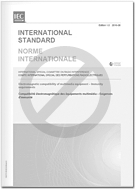
IEC TS 62607-6-4:2024
Nanomanufacturing - Key control characteristics - Part 6-4: Graphene-based materials - Surface conductance: non-contact microwave resonant cavity method
Ausgabedatum:
2024-02
Edition:
2.0
Sprache: EN - englisch
Seitenzahl: 18 VDE-Artnr.: 252652
IEC TS 62607-6-4:2024 has been prepared by IEC technical committee 113: Nanotechnology for electrotechnical products and systems. It is a Technical Specification.
This second edition cancels and replaces the first edition published in 2016. This edition constitutes a technical revision.
This edition includes the following significant technical changes with respect to the previous edition:
a) changed the document title to better reflect its purpose and application:
old title: Graphene – Surface conductance measurement using resonant cavity
new title: Graphene based materials – Surface conductance: non-contact microwave resonant cavity method.
b) replaced former Figure 1 with new Figure 1 and Figure 2, to better illustrate the method’s fundamentals and its implementation for a non-technical reader.
This part of IEC 62607 establishes a standardized method to determine the key control characteristic
a) surface conductance
for films of graphene and graphene-based materials by the
b) non-contact microwave resonant cavity method
The non-contact microwave resonant cavity method monitors the microwave resonant frequency shifts and changes in the cavity’s quality factor during the insertion of the specimen into the microwave cavity, as a function of the specimen surface area. The empty cavity is an air-filled standard R100 rectangular waveguide operated at one of the resonant frequency modes, typically at 7,5 GHz [4].
1) The method is applicable for graphene materials which are synthesized by chemical vapour deposition (CVD) on metal substrates, epitaxial growth on silicon carbide (SiC), obtained from reduced graphene oxide (rGO), or mechanically exfoliated from graphite [5].
2) This measurement does not explicitly depend on the thickness of the nano-carbon layer. The thickness of the specimen does not need to be known, but it is assumed that the lateral dimensions are uniform over the specimen area.
NOTE In some countries, the R100 standard waveguide is referenced as WR-90.

